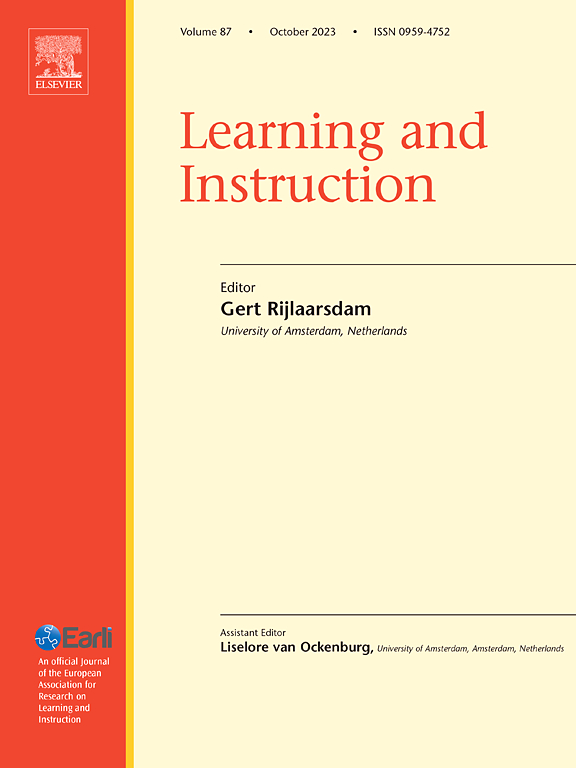教师谈话对小学生科学学习的影响:以人为本的观念变迁分析
IF 4.9
1区 教育学
Q1 EDUCATION & EDUCATIONAL RESEARCH
引用次数: 0
摘要
学生表现出大量的先入为主的观念,经常偏离科学概念。克服这些误解所需的观念变化可以通过不同的途径实现。然而,言语支持策略对这一现象的影响尚不明确。目的本研究旨在考察学生是否同时表现出误解和科学概念,以及言语支持策略如何影响学生的概念发展。样本参与者是来自53个四年级班级的1162名学生。方法通过T1、T2两个时间点的问卷调查,考察学生的观念。使用视频编码来评估教师使用的言语支持策略。进行了潜在特征分析和潜在特征转移分析,并将支持策略作为协变量。结果在T1时发现了“高度误解”、“高度共存”、“高度碎片化”和“高度科学”四个特征。语言支持策略的影响取决于学生在T1阶段所处的环境。在T2阶段,针对T1阶段“高度误解”或“高度碎片化概念”的人采取的重点策略阻碍了向“高度科学概念”的转变。当以“概念高度共存”为出发点时,激活和发声策略的使用对这种转变产生了积极影响。教师需要意识到,在口头支持方面没有放之四海而皆准的解决方案。相反,教师需要不断检查学生的知识水平,并调整他们的策略。本文章由计算机程序翻译,如有差异,请以英文原文为准。
The influence of teacher talk on primary school students’ learning in science: A person-centered approach to analyzing conceptual change
Background
Students show a multitude of preconceptions, that frequently deviate from scientific concepts. The conceptual change that is required to overcome these misconceptions can be achieved through different pathways. However, the influence of verbal support strategies on this phenomenon remains to be elucidated.
Aims
The study aims to examine whether students simultaneously show misconceptions and scientific concepts and how verbal support strategies influence students’ conceptual development.
Sample
Participants were 1162 students from 53 fourth grade classes.
Methods
Students’ conceptions were examined through questionnaires at two time points (T1, T2). Video coding was utilized to assess the verbal support strategies used by teachers. Latent profile analyses and latent profile transition analyses were conducted and support strategies were incorporated as covariates.
Results
Four profiles at T1 were identified: 'high misconceptions', 'high coexistence of conceptions', 'high fragmented conceptions', and 'high scientific concepts'. The impact of verbal support strategies varies depending on the profile to which the students belong at T1. At T2, the transition to the 'high scientific concept' profile was impeded by focus strategies for those in the 'high misconceptions' or 'high fragmented conceptions' profile at T1. This transition was positively influenced by the use of activate and revoicing strategies when the starting point was the 'high coexistence of conceptions' profile.
Conclusion
Teachers need to be aware that there is no one-size-fits-all solution when it comes to verbal support. Rather, teachers need to continuously check students’ knowledge level and adapt their strategies.
求助全文
通过发布文献求助,成功后即可免费获取论文全文。
去求助
来源期刊

Learning and Instruction
Multiple-
CiteScore
11.30
自引率
4.80%
发文量
109
期刊介绍:
As an international, multi-disciplinary, peer-refereed journal, Learning and Instruction provides a platform for the publication of the most advanced scientific research in the areas of learning, development, instruction and teaching. The journal welcomes original empirical investigations. The papers may represent a variety of theoretical perspectives and different methodological approaches. They may refer to any age level, from infants to adults and to a diversity of learning and instructional settings, from laboratory experiments to field studies. The major criteria in the review and the selection process concern the significance of the contribution to the area of learning and instruction, and the rigor of the study.
 求助内容:
求助内容: 应助结果提醒方式:
应助结果提醒方式:


